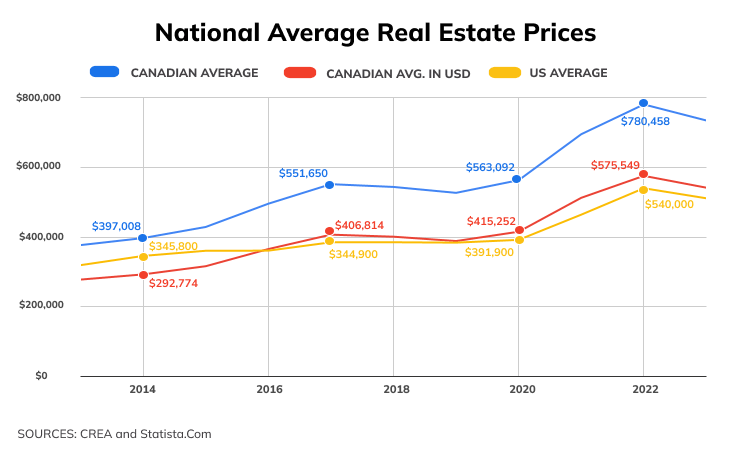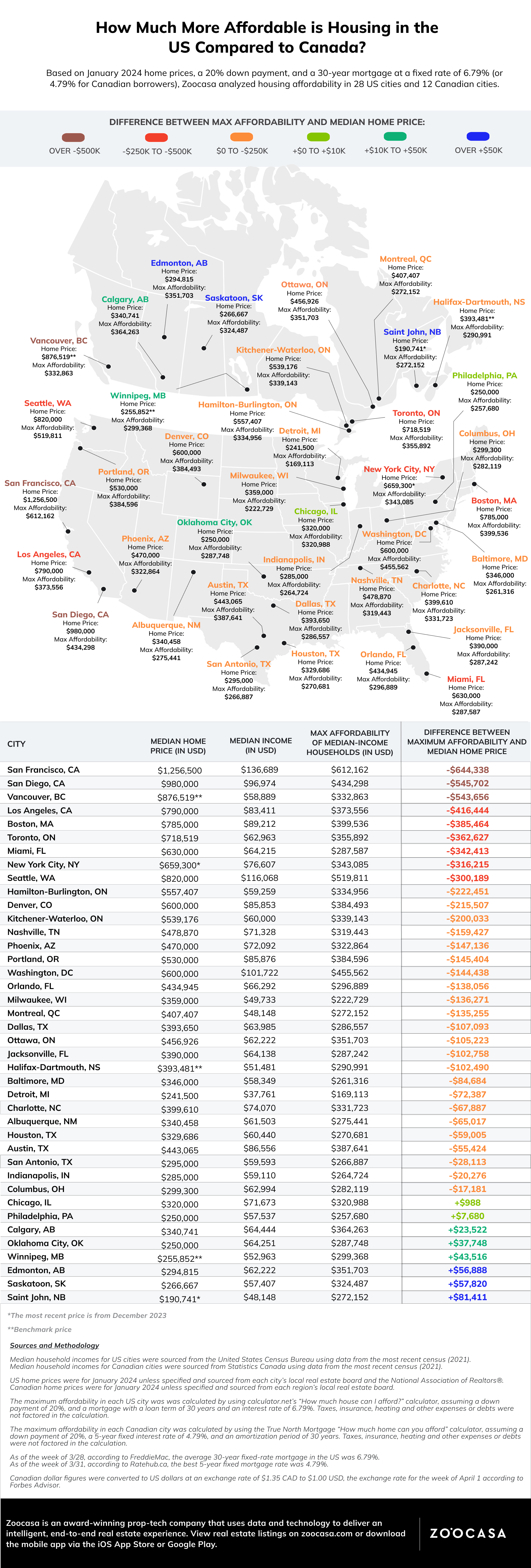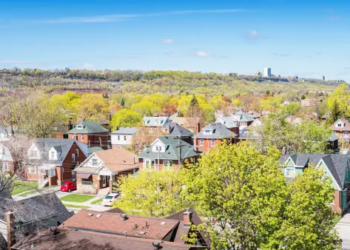When it comes to housing affordability, prospective buyers across North America are facing a narrowing range of options. As home prices have increased, so too has the cost of living. Simultaneously, median incomes have been inching up at a slower rate, further widening the gap between what median-income earners can afford and the actual prices of homes.
While housing markets in both the US and Canada are affected by rising interest rates and low inventory, Canadian buyers are particularly affected, especially as they have smaller median incomes and less buying power. For instance, in 2021, the median household income in the US was $75,149, while in Canada the median household income was $54,074 ($73,000 CAD). The disparity between the two countries becomes more pronounced when examining national average home prices. In 2022, a year when home prices in both nations reached record highs, the average home price in Canada was still over $30,000 higher than in the US, even though Canadians had a median income that was $20,000 lower.


So how much more affordable is housing in the US compared to Canada and is it really as drastic as it seems? To determine the level of housing affordability in 40 cities across North America (28 US cities and 12 Canadian cities), Zoocasa analyzed median home prices, median incomes, and maximum affordability in each.
For the calculation, it was assumed a 20% down payment is made, and the mortgage is taken out over a 30-year timeline (per term for U.S. borrowers, and amortization for Canadian). US affordability was calculated with a fixed mortgage rate of 6.79% (the average on March 28, 2024 according to FreddieMac), while 4.79% was used for Canadian borrowers (the best rate available on the week of March 31, 2024 according to Ratehub.ca). Taxes, insurance, heating, and other expenses and debts were not factored into the calculation. Canadian dollar figures were converted to US dollars at an exchange rate of $1.35 CAD to $1.00 USD.
Enjoying our content? Subscribe to our free weekly newsletter to get real estate market insights, news, and reports straight to your inbox.


The West Coast Has North America’s Least Affordable Housing Markets
San Francisco has the largest gap between the maximum affordability of median-income households and the median home price at a difference of $644,338. However, of all the cities we analyzed, San Francisco has the highest median income meaning homebuyers have greater buying power. Median-income households in San Francisco can afford a home of around $612,162, by far the highest on our list and nearly double what median-income households can afford in Vancouver and Toronto.
Canada’s most expensive real estate market, Vancouver, has the third-largest gap between max affordability and median home price just behind San Diego. With a median income less than half of that in San Francisco, households in Vancouver can afford a home costing around $332,863 – a whopping $543,656 below the benchmark price.
Following Vancouver is Los Angeles, where the median income of $83,411 can afford homebuyers a home costing around $373,556. That comes out to $416,444 less than the median home price of $790,000. Boston rounds out the top five least affordable markets with a difference of $385,464 between the max affordability and median home price.
Canada’s Home Prices Soar Above US Comparisons
Though Toronto’s median income is comparable to Dallas, with Toronto at $62,963 and Dallas at $63,985, housing affordability in each city is far from similar. The median home price in Toronto is $718,519 while in Dallas it is much lower at $393,650. This results in a difference of just $107,093 between maximum affordability and the median home price in Dallas, while in Toronto, the gap more than triples that of Dallas. Households earning the median income in Toronto can afford homes costing around $355,892, which is $362,627 less than the median home price.
This trend is not exclusive to Toronto’s housing market. When comparing housing affordability in Kitchener-Waterloo and Houston, which have near-identical median incomes at $60,000 and $60,440 respectively, Houston emerges as the more affordable market by a considerable amount. In Houston, median-income households can afford a home costing around $270,681, a mere $59,005 below the median home price of $329,686. Despite median-income households in Kitchener-Waterloo being able to afford more expensive homes than their counterparts in Houston, they still face a substantial gap of $200,033 between their maximum affordability and the median home price, which is at $539,176.
Several Canadian Cities Outshine American Counterparts in Affordability
It’s worth noting that of the eight cities where median-income earners can afford the current median home price, five of them are located in Canada: Calgary, Winnipeg, Edmonton, Saskatoon, and Saint John. Oklahoma City is the most affordable US city, where households earning the median income can purchase a home at the current median price and still have money to spare.
Calgary has the highest median household income in Canada at $64,444, which gives homebuyers there enough buying power to afford the median home price of $340,741. Though Jacksonville has a similar median household income and median home price as Calgary, at $64,138 and $390,000 respectively, median-income households cannot afford the median home price. Median-income households in Jacksonville can afford to buy a home costing around $287,242, which is still $102,758 below the median home price.
Edmonton is an even more affordable example. With a median household income of $62,222, households can afford to buy a home costing around $351,703, which is more than $56,888 than the median home price. Meanwhile, in Columbus, where the median income is $62,994, households can only afford to buy a home costing around $282,119, which is $17,181 shy of the median home price.
Planning to enter one of these markets this spring? It’s important to speak with a local realtor who is familiar with your local real estate market. Give us a call today to discuss your home-buying plans.















